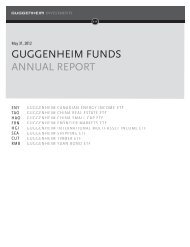Guggenheim Credit Allocation Fund GGM - Guggenheim Investments
Guggenheim Credit Allocation Fund GGM - Guggenheim Investments
Guggenheim Credit Allocation Fund GGM - Guggenheim Investments
- No tags were found...
You also want an ePaper? Increase the reach of your titles
YUMPU automatically turns print PDFs into web optimized ePapers that Google loves.
The <strong>Fund</strong>’s investmentsSenior LoansSenior Loans hold the most senior position in the capital structure of a business entity (the “Borrower”), are typicallysecured with specific collateral and have a claim on the assets and/or stock of the Borrower that is senior to that heldby subordinated debt holders and stockholders of the Borrower. The proceeds of Senior Loans typically are used tofinance leveraged buyouts, recapitalizations, mergers, acquisitions, stock repurchases, refinancings and to financeinternal growth and for other corporate purposes. Senior Loans typically have rates of interest which are redetermineddaily, monthly, quarterly or semi-annually by reference to a base lending rate, plus a premium or credit spread. Thesebase lending rates are primarily the London InterBank Offered Rate (“LIBOR”) and secondarily the prime rateoffered by one or more major U.S. banks and the certificate of deposit rate or other base lending rates used bycommercial lenders.Senior Loans typically have a stated term of between five and nine years, and have interest rates which typically areredetermined daily, monthly, quarterly or semi-annually. Longer interest rate reset periods generally increasefluctuations in the <strong>Fund</strong>’s net asset value as a result of changes in market interest rates. The <strong>Fund</strong> is not subject to anyrestrictions with respect to the maturity of Senior Loans held in its portfolio. As a result, as short-term interest ratesincrease, interest payable to the <strong>Fund</strong> from its investments in Senior Loans should increase, and as short-term interestrates decrease, interest payable to the <strong>Fund</strong> from its investments in Senior Loans should decrease. Because ofprepayments, the Adviser expects the average life of the Senior Loans in which the <strong>Fund</strong> invests to be shorter than thestated maturity.Many Senior Loans in which the <strong>Fund</strong> will invest may not be rated by a rating agency, will not be registered with theSecurities and Exchange Commission (the “SEC”), or any state securities commission, and will not be listed on anynational securities exchange. The amount of public information available with respect to Senior Loans will generallybe less extensive than that available for registered or exchange-listed securities. In evaluating the creditworthiness ofBorrowers, the Adviser will consider, and may rely in part on, analyses performed by others. Borrowers may haveoutstanding debt obligations that are rated below investment grade by a rating agency. Certain of the Senior Loans inwhich the <strong>Fund</strong> will invest will have been assigned below investment grade ratings by rating agencies. In the eventSenior Loans are not rated, they are likely to be the equivalent of below investment grade quality. Because of theprotective features of Senior Loans, the Adviser believes that Senior Loans tend to have more favorable loss recoveryrates as compared to more junior types of below investment grade debt obligations. The Adviser does not viewratings as the determinative factor in its investment decisions and relies more upon its credit analysis abilities thanupon ratings.Although the risks associated with Senior Loans are similar to the risks of below investment grade securities, SeniorLoans are typically senior and secured in contrast to other below investment grade securities, which are oftensubordinated and unsecured. Senior Loans’ higher standing has historically resulted in generally higher recoveries inthe event of a corporate reorganization. In addition, because their interest rates are typically adjusted for changes inshort-term interest rates, Senior Loans generally are subject to less interest rate risk than other below investment gradesecurities, which are typically fixed rate.No active trading market may exist for some Senior Loans, and some loans may be subject to restrictions on resale. Asecondary market may be subject to irregular trading activity, wide bid/ask spreads and extended trade settlementperiods, which may impair the ability to realize full value and thus cause a material decline in the <strong>Fund</strong>’s net assetvalue. In addition, the <strong>Fund</strong> may not be able to readily dispose of its Senior Loans at prices that approximate those atwhich the <strong>Fund</strong> could sell such loans if they were more widely-traded and, as a result of such illiquidity, the <strong>Fund</strong> mayhave to sell other investments or engage in borrowing transactions if necessary to raise cash to meet its obligations.During periods of limited supply and liquidity of Senior Loans, the <strong>Fund</strong>’s yield may be lower.Although changes in prevailing interest rates can be expected to cause some fluctuations in the value of Senior Loans(due to the fact that floating rates on Senior Loans reset only periodically), the value of Senior Loans is substantiallyless sensitive to changes in market interest rates than fixed rate instruments. As a result, to the extent the <strong>Fund</strong> investsin floating-rate Senior Loans, the <strong>Fund</strong>’s portfolio may be less volatile and less sensitive to changes in market interestrates than if the <strong>Fund</strong> invested in fixed rate obligations. Similarly, a sudden and significant increase in market interest31



